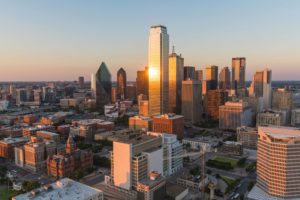






City Wide Building Services is a full service building maintenance company with 40 years of experience maintaining and preserving Texas’ best landmarks. Our professionals are ready to help you maximize the value of your property.
When you think about Texas, chances are that you think about a variety of cities, and near the top of the list is probably Dallas. It’s the third-largest city in Texas and the ninth-largest in the United States, making it one of the major centers for industry and economy in the state.
The diversity of Dallas doesn’t stop at its ethnic and religious backgrounds, either. Dallas’s economy is also hugely diverse, with a variety of sectors throughout the city. That means there are also a huge variety of different buildings scattered around Dallas.
Industrial services have flourished in Dallas with the variety of buildings that need upkeep throughout the city. Regardless of how you’re planning to upkeep your building, City Wide is a great choice for your Dallas industrial needs.
Over 50 years of service have prepared CityWide to provide Texas’s premier complex commercial window cleaning services. Suppose you’re looking for someone to help with the maintenance and management of your commercial building, from high-rise skyscrapers to single-story commercial locations. In that case, CityWide can help you protect and maintain your property so you can focus on providing exceptional service.
On top of our experience in the industry, CityWide also protects $10 million of insurance and the largest team of IWCA Certified Technicians in Texas, ensuring that your building is always in the best hands. This exceptional track record has led to CityWide being trusted with over 4,000 properties. Get the exceptional care that you expect with CityWide.

Window imperfections stand out on commercial buildings, meaning that dirt, smudges, and streaks on the glass are obvious. Whether these imperfections come from not maintaining the glass or an unprofessional cleaning job, they can reflect poorly on your building and your business.
CityWide ensures your windows are sparkly and clean, with no streaks or dirt in sight. Our services allow you to make a great first impression on your clients.
Even if you don’t notice on a day-to-day level, your building’s various surfaces get dirty over time. Commercial pressure washing is a great way to restore those surfaces, cleaning them from dirt that may have built up over weeks, months, or even years. You may have assumed you were dealing with permanent discoloration, but pressure washing can eliminate many of these marks.

Whether you’re looking for cleaning on exterior walls, driveways, sidewalks, or something else, talk to CityWide for more information about commercial pressure washing.
Dallas is one of the most populous cities in Texas, and it’s one of the cities you probably think of first and foremost when you think about Texas as a whole. Dallas prides itself on being extremely bold and very beautiful, which is why you need to think about building maintenance when you’re working in Dallas. Consider these elements of building maintenance: beauty, structure, and DIY.
Beauty is one of the things you’re probably going to think of first when you think of building maintenance. That’s because projecting a great image is one of the biggest things you can do to make people think about using your company. City Wide offers window washing, pressure washing, and high dusting options to help you do just that.
Structural integrity is another important element of a building’s appearance, especially if you’re doing business in a historical town like Dallas. To help you maintain your building’s structural integrity, City Wide offers options like building restoration, anchor inspection, and anchor installation.
There are also some things you can do on your own to maintain your building. If you’re planning to DIY any fixes around your company’s building, City Wide has you covered with equipment rentals and anchor load test certification options.
The architecture in Dallas tends to vary dramatically when it comes to specific style. Many smaller buildings take on a variety of styles ranging from Gothic revival to neoclassical, and the Dallas Downtown Historical District provides access to a cross-section of commercial designs from the 1880s to the 1920s.
With twenty skyscrapers over 150 meters or 492 feet tall, Dallas’s skyline is certainly nothing to shake a stick at. As a matter of fact, the Praetorian Building, which completed construction in 1909, was the first skyscraper in the Western United States. Today, the Bank of America Plaza, standing at a height of 921 feet or 74 floors, is the tallest building in Dallas as well as the third-tallest in Texas.
Initially, Spanish colonists claimed the area people now know as Dallas in the 18th century. However, it didn’t become an American city until 1841, and its official incorporation was in 1856. That means there’s well over 150 years of history to look back through when you start looking into Dallas.
Regardless of where in Dallas you live, it’s definitely a sight to behold. The architectural design of Dallas is some of the most stunning design that you can see in the United States, and many tourists and residents alike marvel at Dallas’ design opportunities.
All buildings deal with entropy over time, which means you will experience issues with your building at some point. The best way to deal with these issues is to handle them early on — if you wait, you risk allowing the problem to develop, requiring more expensive and more difficult restoration services.
When you first notice issues with your building’s exterior, contact Citywide. These building restoration services can help you restore your building to its former glory as easily as possible.
High-rise buildings require you to have well-functioning roof anchor systems, which allow your building to hold up crew and equipment that need to access the exterior of the building. To ensure the safety of these individuals, the government requires both initial certification and annual inspection for your systems.
Whether you’re adding roof anchor systems to your building or need an expert for certification, CityWide can offer annual inspections, load test certification, anchor assessments, and installation services.
Are there spots in your building you need help to reach with a basic ladder? If so, you may need an atrium lift called a compact crawler lift. The compact design of these lifts allows them to enter doors and go down stairways, helping people access high areas of your building, whether you need it for light replacement, interior window cleaning, or something else entirely.
Our atrium lifts allow you to reach heights between 19 and 95 feet. If you need a lift operator, CityWide can also provide a well-trained operator. Contact us today to learn more about our options.
There are many buildings with special architecture out there. Whether you own a building with special historical value or one with an especially prestigious designer, you may require a restoration expert to understand these special architectural concerns when dealing with building deterioration over time. CityWide can provide wet glazing and sealing windows, crack repair services, rust and stain removal, and concrete repair and cleaning in these situations.
Take action to make sure your building looks and performs its best. Contact CityWide for more information about architectural restoration.












With over 50 years of experience, CityWide is proud to be Texas’s premier complex commercial window cleaning company. Regardless of your needs, from high-rise skyscrapers to single-story retail locations, CityWide is a company that you can trust to maintain and protect your properties.
On top of our extensive history, CityWide also retains $10 million of insurance, employs the largest team of International Window Cleaning Association (IWCA) certified technicians in all of Texas, and plays a role in maintaining over 4,000 properties. You can trust that CityWide will provide you with the excellent care you expect from your window cleaning services.



©Copyright 2020 City Wide Building Services, All Rights Reserved.